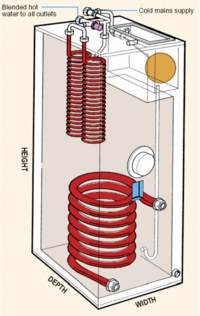Looking to the future of domestic hot water

• Where combined heat and power (CHP) is used, how can each apartment be connected and also give individual control?
• Where low-temperature renewables are used (such as heat pumps or solar) how can the domestic hot water be brought to useable temperatures?
Elson, which has been in the business of designing water heating systems for over 90 years, has focused its business on these new challenges. Central boiler plant SAP ratings and gas safety requirements are increasingly driving developers and designers towards central boiler plant rather than individual boilers in each apartment. In such projects the Coral CB Si can act as the interface between the central boiler plant and each apartment. A storage vessel contains water that is heated by the central plant and used to heat incoming cold mains water (see diagram). The Coral provides the hot water supply and can be designed to be a prefabricated airing cupboard, even including space for a washing machine with the water and waste connections ready plumbed. A central heat source means that renewable energy inputs, especially solar, become viable as there is no need to feed the solar input into each apartment. This approach is already in use by some of the largest UK developers, and others are at the planning stage. CHP Large-scale building projects with shops, flats and offices within the same complex offer opportunities for the major investment required in CHP. Since the power side of the plant is designed for continuous running, control is required between the heating mains and each apartment. Here Elson can offer the APV Compakva. Within each apartment the constant pressure and temperature heating mains interface with the apartment using a plate heat exchanger. These compact wall-mounted units provide individual control of heating and hot water in the same way as if a boiler were installed in the apartment. The coupled heat exchanger delivers both heating and hot water, reducing piping complexity and space. The plates of the exchanger are bolted together and can be cleaned easily. Rapid response to demand for hot water is provided by two thermostatic valves controlling heating and hot water at a consistent temperature. The hot water temperature is held at ‘idle’ when not in use, so running temperature is reached in seconds when a demand is made. A pump with a built-in frequency converter reduces noise within the unit and cuts energy use by 40%. Renewables Another interesting new development is the use of renewables, usually heat pumps, to serve schemes of groups of buildings — mini district heating in a way. The requirement is to provide domestic hot water at usable temperatures and ensure that conditions for legionella do not arise — whilst taking maximum advantage of the green energy from the heat pump.
 |
The thermal store in a Coral Si unit is heated by the central plant and heats incoming cold mains water to deliver domestic hot water. |







